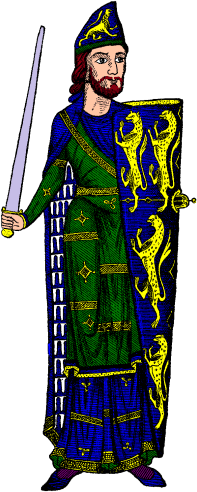
 |
| FIG. 28.--Taken from the tomb of Geoffrey Plantagenet, Count of Anjou. |
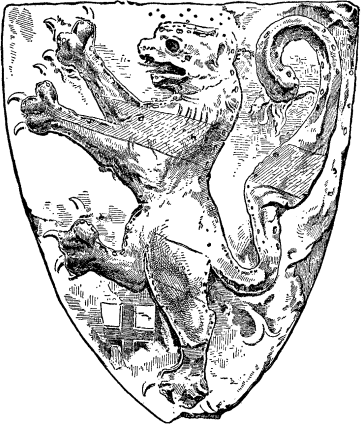 |
| FIG. 29.--Shield of the Landgrave Konrad of Thuringia (died 1241). |
 is 90 centimetres high and 74 wide. Konrad was Landgrave of Thuringia and Grand Master of the Teutonic Order of Knighthood. His arms show the lion of Thuringia barry of gules and argent on a field of azure,
and between the hind feet a small shield, with the arms of the Teutonic Order of Knights. The only remains of the lion's mane are traces of the nails. The body of the lion is made of pressed leather, and the yellow claws have been supplied with a paint-brush. A precious stone probably represented the eye.
is 90 centimetres high and 74 wide. Konrad was Landgrave of Thuringia and Grand Master of the Teutonic Order of Knighthood. His arms show the lion of Thuringia barry of gules and argent on a field of azure,
and between the hind feet a small shield, with the arms of the Teutonic Order of Knights. The only remains of the lion's mane are traces of the nails. The body of the lion is made of pressed leather, and the yellow claws have been supplied with a paint-brush. A precious stone probably represented the eye.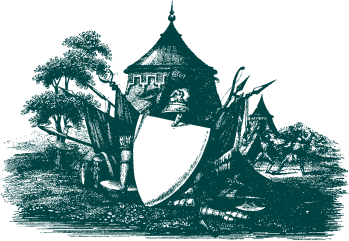 |
| FIG. 30. |
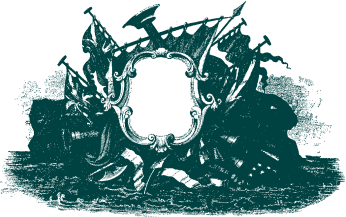 |
| FIG. 31. |
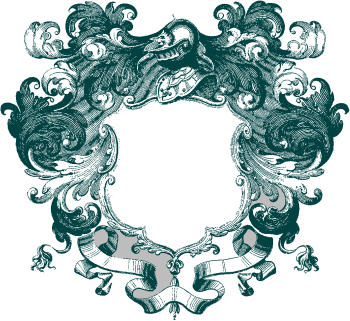 |
| FIG. 32. |

 in which, alluding to heraldic art in general, he says (p. 235):--
in which, alluding to heraldic art in general, he says (p. 235):--
 The book is not particularly well known to the public, inasmuch as its circulation was entirely confined to heraldic artists, coach-painters, engravers, and die-sinkers. Amongst these handicraftsmen its reputation was and is great. With the school of design it adopted, little or no sympathy now exists, but a short time ago (how short many of those who are now vigorous advocates of the Gothic and
mediæval styles would be startled to realise were they to recognise actual facts) no other style was known or considered by the public. As examples of that style the plates of Knight and Rumley were admittedly far in advance of any other book, and as specimens of copperplate engraving they are superb. Figs. 30, 31, and 32 show typical examples of escutcheons from Knight and Rumley; and as the volume was in the hands of most of the heraldic handicraftsmen, it will be found that this type of design was constantly to be met with. The external decoration of the shield was carried to great lengths, and Fig. 31 found many admirers and users amongst the gallant "sea-dogs" of the kingdom. In fact, so far was the idea carried that a trophy of military weapons was actually granted by patent as part of the supporters of the Earl of Bantry. Fig. 30, from the same source, is the military
equivalent. These plates are interesting as being some of the examples from which most of the heraldic handicraft of a recent period was adapted. The official shield eventually stereotyped itself into a shape akin to that shown in Fig. 32, though nowadays considerable latitude is permitted. For paintings which are not upon patents the design of the shield rests with the individual taste of the different officers of arms, and recently some of the work for which they have been responsible has reached a high standard judged even by the strictest canons of art. In Scotland, until very recently, the actual workmanship of the emblazonments which were issued from Lyon Office was so wretchedly poor that one is hardly justified in taking them into consideration as a type. With the advent into office of the present Lyon King of Arms (Sir James Balfour Paul), a complete
change has been made, and both the workmanship and design of the paintings upon the patents of grant and matriculation, and also in the Lyon Register, have been examples of everything that could be desired.
The book is not particularly well known to the public, inasmuch as its circulation was entirely confined to heraldic artists, coach-painters, engravers, and die-sinkers. Amongst these handicraftsmen its reputation was and is great. With the school of design it adopted, little or no sympathy now exists, but a short time ago (how short many of those who are now vigorous advocates of the Gothic and
mediæval styles would be startled to realise were they to recognise actual facts) no other style was known or considered by the public. As examples of that style the plates of Knight and Rumley were admittedly far in advance of any other book, and as specimens of copperplate engraving they are superb. Figs. 30, 31, and 32 show typical examples of escutcheons from Knight and Rumley; and as the volume was in the hands of most of the heraldic handicraftsmen, it will be found that this type of design was constantly to be met with. The external decoration of the shield was carried to great lengths, and Fig. 31 found many admirers and users amongst the gallant "sea-dogs" of the kingdom. In fact, so far was the idea carried that a trophy of military weapons was actually granted by patent as part of the supporters of the Earl of Bantry. Fig. 30, from the same source, is the military
equivalent. These plates are interesting as being some of the examples from which most of the heraldic handicraft of a recent period was adapted. The official shield eventually stereotyped itself into a shape akin to that shown in Fig. 32, though nowadays considerable latitude is permitted. For paintings which are not upon patents the design of the shield rests with the individual taste of the different officers of arms, and recently some of the work for which they have been responsible has reached a high standard judged even by the strictest canons of art. In Scotland, until very recently, the actual workmanship of the emblazonments which were issued from Lyon Office was so wretchedly poor that one is hardly justified in taking them into consideration as a type. With the advent into office of the present Lyon King of Arms (Sir James Balfour Paul), a complete
change has been made, and both the workmanship and design of the paintings upon the patents of grant and matriculation, and also in the Lyon Register, have been examples of everything that could be desired.